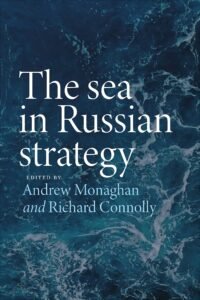 The sea in Russian strategy
The sea in Russian strategy
Edited by Andrew Monaghan and Richard Connolly
Publisher: Manchester University Press (August 2023)
272 pages, English
$21.95
Understanding Russia’s foreign policy or strategy in the post-Ukraine war era may be complex to most of us. Reading a few articles in western media on Russia, or traveling a few times to Russia, won’t make us experts on Russian politics. Andrew Monaghan and Richard Connolly are two of the few western experts who write objectively on Russia by analyzing reports and literature published by Russian political and military experts. In their recent edited volume, The sea in Russian strategy, they provide a very timely contribution regarding Moscow’s maritime capability and intent.
For those who are interested in Russia’s foreign policy, the book is valuable for two reasons. First, it helps us to compare Russian strategy and shipbuilding plans within the context of the war in Ukraine. Second, while it argues that Russia’s land and air forces received a heavy blow in the Ukraine war, its naval force is stronger than ever.
The sea in Russian strategy is also the first well-written examination of Russia’s maritime power after the fall of the Soviet Union. The book brings together leading experts (with history, military and security backgrounds) to reflect on historical and contemporary aspects of Russia’s naval strategy and capacities. The authors also provide special attention to the Arctic region at a time of mounting tensions between Russia and NATO which some experts call the “Fourth Battle of the Atlantic.” The experts also sketch a trajectory of Russia’s power at sea and consider current capabilities and problems, as well as the Kremlin’s strategic planning for the future.
In the book, the term sea power, which is relatively used to encompass military and non-military dimensions, is a significant component of Russia’s wider strategy and is likely to rise in importance. The sea is seen as vital to domestic industrial and regional development. To develop Russia’s Arctic and offshore natural resource base, huge investment is being made in Russia’s domestic shipbuilding industry and in building capabilities to extract and transport oil and gas.
By the year 2000, as the experts mention in the book, there were debates in Moscow that “Russia may lose its status as the world’s second strongest naval power,” where in the Baltic, Russia would become inferior to Germany and Sweden, and in the Black Sea region, it would be inferior to Turkey. However, this has changed in the last two decades as President Putin heavily invested in Russia’s naval forces.
According to the authors, it is increasingly important to have a nuanced grasp of the sea in contemporary Russian strategy for three interconnected primary reasons. First, there is a wider “maritime turn” in international affairs of which Russia is a part. Second, the sea is more significant in the Russian leadership’s thinking and activity—the Russian naval activity in the Black, Caspian and Mediterranean Seas, in addition to the Arctic Ocean reflects this thinking. Finally, throughout the ages, Russia’s perception of the sea has changed based on certain geopolitical and geo-economic developments. One needs to explain these three reasons.
First, the sea serves as a connective fiber of global power, with growth in global trade by sea. Analysts suggest that some 80 to 90-percent of global trade by volume is seaborne. This has led to a dramatic increase in spending on navies. In Asia, China, India, Japan and Australia started upgrading their naval forces and investing in key ports. This fact has led to a “paradigm shift” in naval matters with the development of new submarines and carrier-killer missiles. For this reason, Russian ports are used as “secure hubs,” not only to prevent long-ranged attacks against the Russian navy or key coastal cities, but also to secure maritime trade routes as an alternative to land routes that can be easily exposed and vulnerable to security risks (sanctions, terror attacks, wars, etc.).
Second, the sea has economic importance to the Russian leadership. While Russia’s imports from Asia have grown since 2014, largely by sea, the Russian economy depends on the ability to exploit and export hydrocarbons and agricultural products by sea. Logistical and transport infrastructure is being built to support this. For this reason, Russia is developing its infrastructure in the North to facilitate the Northern Sea Route (NRS) and the Black Sea to export grain to the Middle East and North Africa. The linking of railways and highways to ports aiming to create a cross-continental bridge between seas and oceans is a prominent feature in speeches by senior Russian officials who are concerned about their country’s geo-economic interests. This is why when the Suez Canal was blocked (March 2021), Moscow seized the opportunity to emphasize the advantages that the NRS would bring to global trade.
Third, geography and history mean there are a number of noteworthy specificities in the way Russia looks at the sea. Geography imposes significant challenges on the way Moscow determines strategy at sea, creating specific ambiguities in the heat of thinking about power at sea. While Russia is usually known as a continental (Eurasian) power, it also has the longest seaboard in the world. It is worth mentioning that within the Russian collective historical memory, it is always emphasized that most military defeats have been brought from the sea, such as the Crimean War (1854-1856) and the Russo-Japanese War (1904-1905). Hence, historically, Russia has been challenged by power projected from the sea; therefore, it prioritizes its ground forces. Meanwhile, the navy is a junior service and used as a deterrent force.
Moreover, despite its long seaboard, as the book argues, Russia has few outlets for its own naval deployment. Its bases are separated by thousands of miles, and access to the seas and oceans is only possible through narrow exits and choke points. This is what drives the Russian navy’s division into four fleets and a flotilla and automatically puts it at a serious disadvantage compared to other major powers, since it generates logistical problems and difficulties in reinforcement.
Hence, Russia’s strategy at sea illuminates a key feature of contemporary national power and long-term trajectory of growth, and, within this, Moscow’s priorities and choices as well as the concepts that underpin its activities. Importantly, as the authors of the book mention, as Russia’s maritime economic interests grow, and with it the importance of the sea to its grand strategy, the need to guarantee sea lines communication and to bolster Russia’s military presence abroad will increase.



Be the first to comment